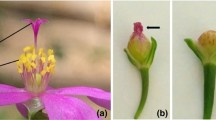Abstract
Differences in rate of wilting in cross-, self-and unpollinated flowers of self-incompatiblePetunia hybrida L. clone W166H appeared to be significant. Wilting rate was fastest following cross-pollination and slowest in unpollinated flowers. The difference between wilting behaviour of cross- and self-pollinated flowers was not caused by rate of pollen tube growth and not by the incompatibility (recognition or rejection) reaction either. It is assumed, that, following pollination, the wilting reaction is only retarded after penetration of pollen tubes of the same genetic composition as the style (complete self-pollination). The number of viable pollen grains necessary to initiate a maximal wilting-rate of flowers following cross- and self-pollination is about 800, which means that a fifth of the stigmatic surface must be covered with living pollen grains. It is suggested that pollen tube penetration and injury of the style have a similar influence on the initiation of wilting.
Wilting-rate following pollination is faster in young plants as compared with wilting in old plants. The wilting process of unpollinated and self-pollinated flowers started in the early morning and lasted till afternoon. Cross-pollinated flowers wilted independently of the hour of the day. The role of flower-wilting as a means of communication to the environment with regard to pollination of the style is discussed.
Similar content being viewed by others
References
Arditti, J., Flick, H.: Post-pollination phenomena in orchid flowers. VI. Excised floral segments ofCymbidium. Amer. J. Bot.63, 201–211 (1976)
Brantjes, N.B.M.: Sphingophilous flowers, function of their scent. In: Pollination and dispersal, pp. 27–46. Brantjes, N.B.M. and Linskens, H.F. (Eds.). Nijmegen: University, Department of Botany 1973
Burg, S.P., Burg, E.A.: The interaction between auxin and ethylene and its role in plant growth. Proc. nat. Acad. Sci. (Wash.)55, 262–269 (1966)
Deurenberg, J.J.M.: In vitro protein synthesis with polysomes from unpollinated, cross- and self-pollinatedPetunia ovaries. Planta (Berl.)128, 29–33 (1976)
Gilissen, L.J.W.: The role of the style as a sense-organ in relation to wilting of the flower. Planta (Berl.)131, 201–202 (1976)
Gilissen, L.J.W., Linskens, H.F.: Pollen tube growth in styles of self-incompatiblePetunia pollinated with irradiated pollen and with foreign pollen mixtures. In: Gamete competition in plants and animals, pp. 201–205. Mulcahy, D.L. (Ed.). Amsterdam: North Holland Publishing Company 1975
Hall, I.V., Forsyth, F.R.: Production of ethylene by flowers following pollination and treatments with water and auxin. Canad. J. Bot.45, 1163–1166 (1967)
Heslop-Harrison, J., Heslop-Harrison, Y., Knox, R.B., Howlett, B.: Pollen-wall proteins: “gametophytic” and “sporophytic” fractions in the pollen walls of theMalvaceae. Ann. Bot.37, 403–412 (1973)
Kirby, E.G., Smith, J.E.: Elutable substances of pollen grain walls. In: Fertilization in higher plants, pp. 127–130. Linkens, H.F. (Ed.). Amsterdam: North Holland Publishing Company 1974
Linskens, H.F.: Translocation phenomena in thePetunia flower after self- and cross-pollination. In: Fertilization in higher plants, pp. 285–292. Linskens, H.F. (Ed.). Amsterdam: North Holland Publishing Company 1974
Linskens, H.F., Esser, K.: Über eine spezifische Anfärbung der Pollenschäuche im Griffel und die Zahl der Kallosepfropfen nach Selbstung und Fremdung. Naturwissenschaften44, 16 (1957)
Linskens, H.F., Schrauwen, J.: The release of free amino acids out of the germinating pollen. Acta Bot. Neerl.18, 605–614 (1969)
Stanley, R.G., Linskens, H.F.: Protein-diffusion from germinating pollen. Physiol. Plant.18, 47–53 (1965)
Author information
Authors and Affiliations
Rights and permissions
About this article
Cite this article
Gilissen, L.J.W. Style-controlled wilting of the flower. Planta 133, 275–280 (1977). https://doi.org/10.1007/BF00380689
Received:
Accepted:
Issue Date:
DOI: https://doi.org/10.1007/BF00380689




